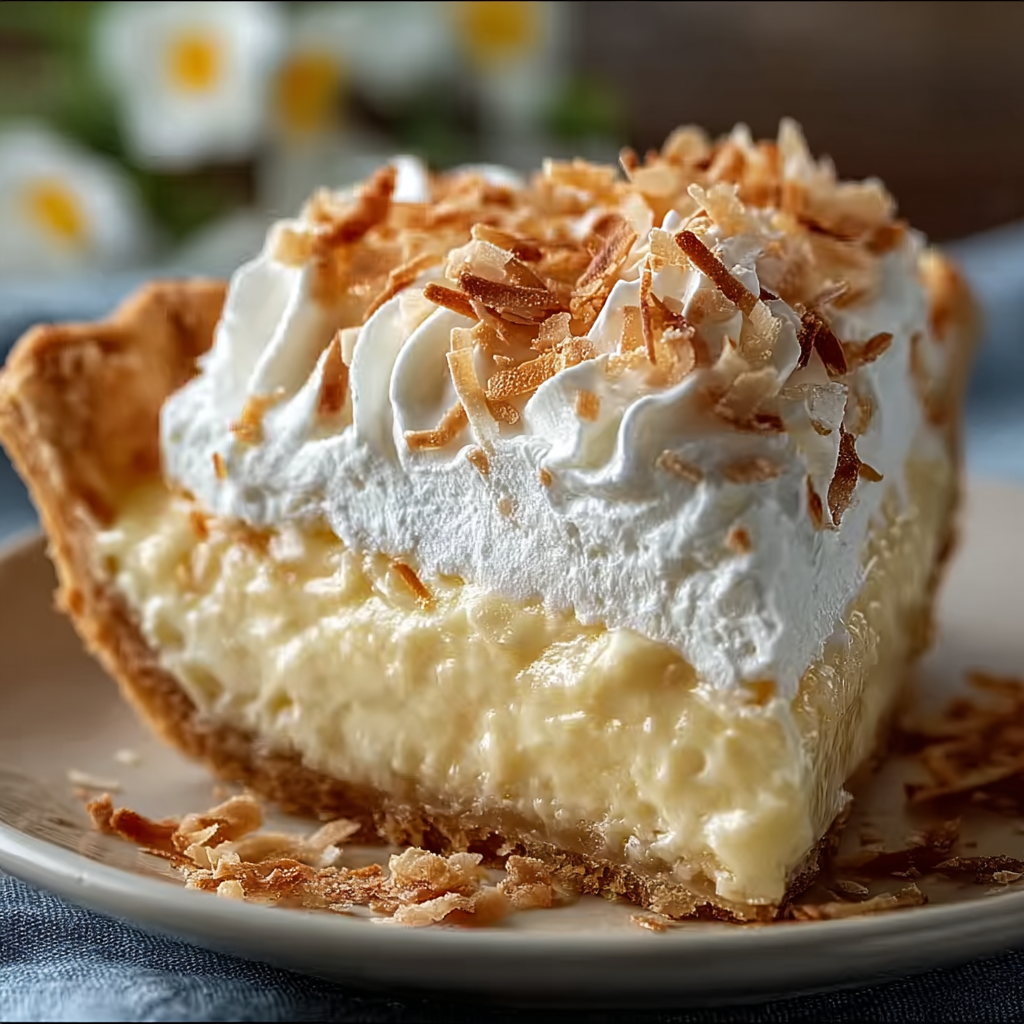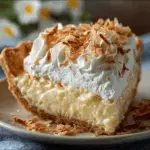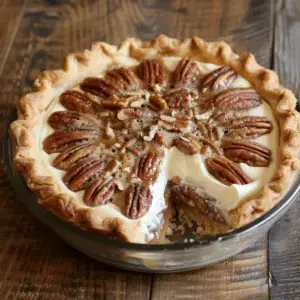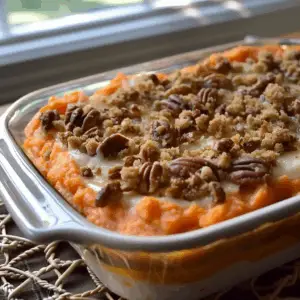Toasted Coconut Cream Pie: A Lush, Tropical Dessert with Crunch and Creaminess
This toasted coconut cream pie features a crisp, buttery graham cracker crust, a smooth coconut custard filling, and fluffy whipped topping. Its combination of creamy, crunchy, and toasted textures makes it an irresistible centerpiece for summer parties, holiday feasts, or casual family gatherings.
In the How to Make the Perfect Graham Cracker Crust section, you’ll discover how to create a sturdy, even base by combining graham cracker crumbs with melted butter and sugar, then pressing it into the pan for optimal structure and flavor.
Next, Preparing the Creamy Coconut Custard Filling walks you through creating a rich, velvety filling using full-fat coconut milk and tempered egg yolks for a silky consistency. Tips on handling coconut solids and whipping cream properly ensure your filling stays smooth and luscious.
The How to Toast Coconut Flakes portion explains how to achieve evenly golden, aromatic flakes for both flavor and decoration. You’ll find ideas for garnishing your pie with toasted coconut, plus decorating tips to elevate the final presentation.
Additionally, you’ll learn expert Pie Crust Press Techniques, explore other Summer Coconut Dessert Ideas, and use smart Make-Ahead Pie Strategies to simplify prep and impress guests without stress.
To wrap up, the guide includes Flavor Variations, Storage Tips, and a detailed FAQ answering common questions about coconut desserts—making this your ultimate resource for mastering coconut cream pie from crust to topping.

Why Coconut Cream Pie Is Simply Irresistible
Toasted coconut cream pie delivers a flavor experience that’s both nostalgic and indulgent. Each bite combines the natural sweetness of coconut with nutty undertones and a subtle tang, all wrapped in a silky, tropical custard. The addition of vanilla adds warmth and depth, creating a harmonious balance that never overwhelms the palate.
What truly sets this dessert apart is the contrast of textures. The crisp, buttery graham cracker crust—mastered in Crafting the Perfect Graham Cracker Crust—provides a crunchy counterpoint to the luscious, creamy filling. This satisfying interplay highlights the custard’s structure and elevates the pie’s overall appeal, as showcased in Preparing the Creamy Coconut Filling.
Steeped in family tradition, coconut cream pie is a summertime staple that often graces potlucks, backyard gatherings, and festive tables. It captures the spirit of warm-weather celebrations with every slice. Dive into more tropical inspiration with these summer coconut dessert ideas, and enhance each serving by exploring the art of Toasting the Coconut and Whipping the Cream Topping—simple steps that bring out the best in every bite.
Ingredient Spotlight: Building Blocks of a Perfect Toasted Coconut Cream Pie
Crafting a show-stopping toasted coconut cream pie starts with selecting premium ingredients. Each element plays a distinct role in creating the pie’s iconic flavor, texture, and structure—from the crust to the airy topping.
Graham Cracker Crumbs
Offer a crisp, buttery base that complements the smooth filling. When combined with melted butter, they form a sturdy crust that stays crisp. See Crafting the Perfect Graham Cracker Crust for preparation techniques.
Butter & Sugar
These essentials add richness and caramelize slightly during baking, delivering depth and a beautiful golden hue to the crust.
Whole Milk + Coconut Milk
This duo balances creaminess with tropical notes. Whole milk lightens the richness of coconut milk while helping the custard set to a silky finish. Explore more in Preparing the Creamy Coconut Filling.
Egg Yolks & Cornstarch
Together, they form the custard’s foundation. Egg yolks contribute richness, while cornstarch ensures a smooth, stable texture. Proper egg tempering is key—learn more about tempering eggs to prevent curdling during cooking.
Sweetened Shredded Coconut
Adds chewiness and deepens the coconut profile. It brings both flavor and texture to the filling and garnish.
Heavy Whipping Cream
When whipped to soft or firm peaks, it provides a fluffy, cloud-like topping that contrasts the dense custard. See Toasting the Coconut and Whipping the Cream Topping for techniques that enhance both structure and taste.
Flavor Enhancers: Vanilla & Salt
Pure vanilla extract adds warm, aromatic depth, while a pinch of salt sharpens sweetness and balances the overall profile.
For decorative touches, check out Pinterest garnishing ideas and explore summer coconut dessert inspiration for visual styling guides.
Every ingredient has a purpose—and mastering how they work together will help you create a coconut cream pie that’s both elegant and unforgettable.
Crafting the Perfect Graham Cracker Crust
Crafting the perfect graham cracker crust lays the foundation for a stellar dessert. This golden base offers structure and a buttery flavor that complements the coconut filling seamlessly. Precision in each step ensures a crisp, crack-resistant crust.
Follow these step-by-step instructions before moving on to Preparing the Creamy Coconut Filling. For an in-depth understanding of crumb ratios and binding, you might reference technical details on graham crackers.
-
Crush uniformly
-
Use a food processor for consistent texture, or seal crumbs in a heavy-duty bag and roll with a pin.
-
Aim for fine, sand-like granules to allow even mixing and pressing.
-
-
Mix binding agents
-
Combine 1½ cups of crushed crumbs with ⅓ cup melted butter and ¼ cup granulated sugar.
-
Stir until every particle is coated, yielding a homogenous mixture.
-
-
Press and shape
-
Evenly distribute the crumb blend into a 9-inch pie plate.
-
Use the bottom of a flat cup to firmly press crumbs up the sides and across the base, creating a compact, uniform layer.
-
-
Blind-bake
-
Bake at 350°F (175°C) for 10 minutes, until the edge turns golden.
-
Remove and cool completely to prevent moisture from weakening the crust integrity.
-
Variations:
Experiment with spiced variations by stirring in cinnamon or cardamom into the crumbs, or substitute half the mixture with freshly ground almonds or pecans to introduce a nutty complexity. Ensuring your crust is completely cool easily sets the stage for a flawlessly set filling without mixing in steam. Avoid pressing too hard.
Troubleshooting & Pro Tips
If your crust cracks or recedes during baking, try chilling it for 10 minutes before blind-baking. For additional inspiration, proceed to Toasting the Coconut and Whipping the Cream Topping to finish the pie assembly.
Preparing the Creamy Coconut Filling
Building the creamy coconut filling begins with combining whole milk, coconut milk, granulated sugar, cornstarch, and salt in a saucepan over medium heat. Whisk continuously to dissolve sugar and prevent lumps. The addition of cornstarch ensures the custard thickens properly, forming the base of a luxuriously smooth layer. Stir until the mixture starts to steam, but avoid boiling to maintain a stable texture.
Before incorporating the egg yolks, temper them gradually to avoid scrambling. Slowly whisk a small amount of the hot milk mixture into the yolks, then return the yolk blend to the saucepan. Maintain a gentle heat and continue stirring; the filling will thicken and reach the ribbon stage, indicating readiness. This approach honors classic tempering eggs techniques and ensures harmony between dairy and tropical flavors found in coconut milk and pure coconut. For design ideas, check out summer coconut desserts and learn structural tips from pie crust press techniques. Preview how the whipped topping will enhance contrast by reviewing whipped cream methods.
Once the custard has thickened, remove from heat and stir in soft butter and vanilla extract. Fold in sweetened shredded coconut for texture, and strain the mixture for a polished finish. If you prefer a golden accent, explore toasted coconut garnish ideas or elegant coconut cream pie decoration examples. Planning ahead? Use make-ahead pie tips to time chilling and assembly. Finally, pour the filling into the cooled crust from the Crafting the Perfect Graham Cracker Crust section and proceed to Toasting the Coconut and Whipping the Cream Topping once set.
During cooking, watch for small edge bubbles and a consistency that coats a spoon’s back. If too runny, whisk longer; if too thick, stir in milk. Strain through a fine-mesh sieve for a glossy finish. When cooled, the custard will set firmly, ready for topping.

Toasting the Coconut and Whipping the Cream Topping
Transforming plain coconut into a golden, crunchy garnish and creating a light whipped cream accentuates both contrast and tropical flair. Begin by spreading sweetened shredded coconut in an even layer on a rimmed baking sheet. For the first method, bake at 325°F (163°C) for 5–7 minutes, stirring every two minutes until edges turn light brown. Alternatively, in a skillet over medium heat, continuously toss coconut until uniformly golden, about 3–4 minutes. Remove immediately to prevent burning and cool on parchment.
In Preparing the Creamy Coconut Filling, the custard’s smooth surface benefits from a crisp topper. Next, chill a metal bowl and whisk in your freezer for ten minutes. Pour 1 cup of heavy whipping cream with 2 tablespoons of powdered sugar and ½ teaspoon vanilla extract into the chilled bowl. Using an electric mixer on medium speed, whip until soft peaks form—stop before overbeating.
Pro Tips:
-
Ensure all equipment is cold to improve volume and stability.
-
Adjust sugar to taste for optimal sweetness.
-
Reserve extra toasted coconut for presentation atop each slice.
Once whipped and toasted, assemble as detailed in Assembling, Chilling, and Serving to complete this irresistible coconut cream pie dessert.
Assembling, Chilling, and Serving
Once your graham cracker crust is completely cool and the coconut filling has set, you’re ready to assemble. Pour the chilled custard into the prepared crust, using an offset spatula to smooth the surface and remove air pockets. Immediately press a sheet of plastic wrap directly onto the custard to prevent a skin from forming. Refrigerate for at least four hours, or ideally overnight, until the pie is fully firm.
To serve:
-
Remove the plastic wrap and gently run a thin, hot knife around the edge to loosen.
-
Pile or pipe the whipped cream topping evenly over the custard.
-
Sprinkle with the reserved toasted coconut for a golden crust of crunchy texture.
-
Slice with a sharp knife dipped in hot water and wiped between cuts for clean slices.
Present on a chilled platter or cake stand. Each slice offers a perfect balance of crispy crust, smooth custard, and airy cream—an unforgettable tropical dessert experience.
Flavor Variations and Expert Tips
Elevate your toasted coconut cream pie with creative twists:
-
Citrus Zest: Fold in 1–2 teaspoons of lime or lemon zest into the custard for bright acidity.
-
Tropical Swirl: Layer a thin pineapple or mango purée between crust and filling for fruity streaks.
-
Chocolate Drizzle: Melt dark chocolate and drizzle over whipped cream just before serving.
-
Nutty Crunch: Mix chopped macadamia or pecans into the crust for added texture.
-
Boozy Boost: Stir 2 tablespoons of rum or coconut liqueur into the filling for depth.
Expert Tips:
-
Always chill bowls and beaters for the whipped cream.
-
Use fresh coconut for toasting—avoid pre-toasted varieties.
-
Strain custard through a fine sieve for silkiest texture.
-
Adjust sugar in whipped cream to balance the custard’s sweetness.
Storage, Make-Ahead, and Reheating
Proper storage preserves your pie’s ideal texture:
-
Refrigeration: Keep covered in the fridge for up to 4 days.
-
Freezing: Freeze individual slices on a tray, then wrap and store in an airtight container for up to 1 month. Thaw in the fridge overnight.
-
Make-Ahead: Bake crust and prepare filling up to two days in advance. Whip cream and toast coconut on the day of serving.
-
Re-crisping Crust: Briefly bake slices at 300°F (150°C) for 3–5 minutes before serving to revive crunch.
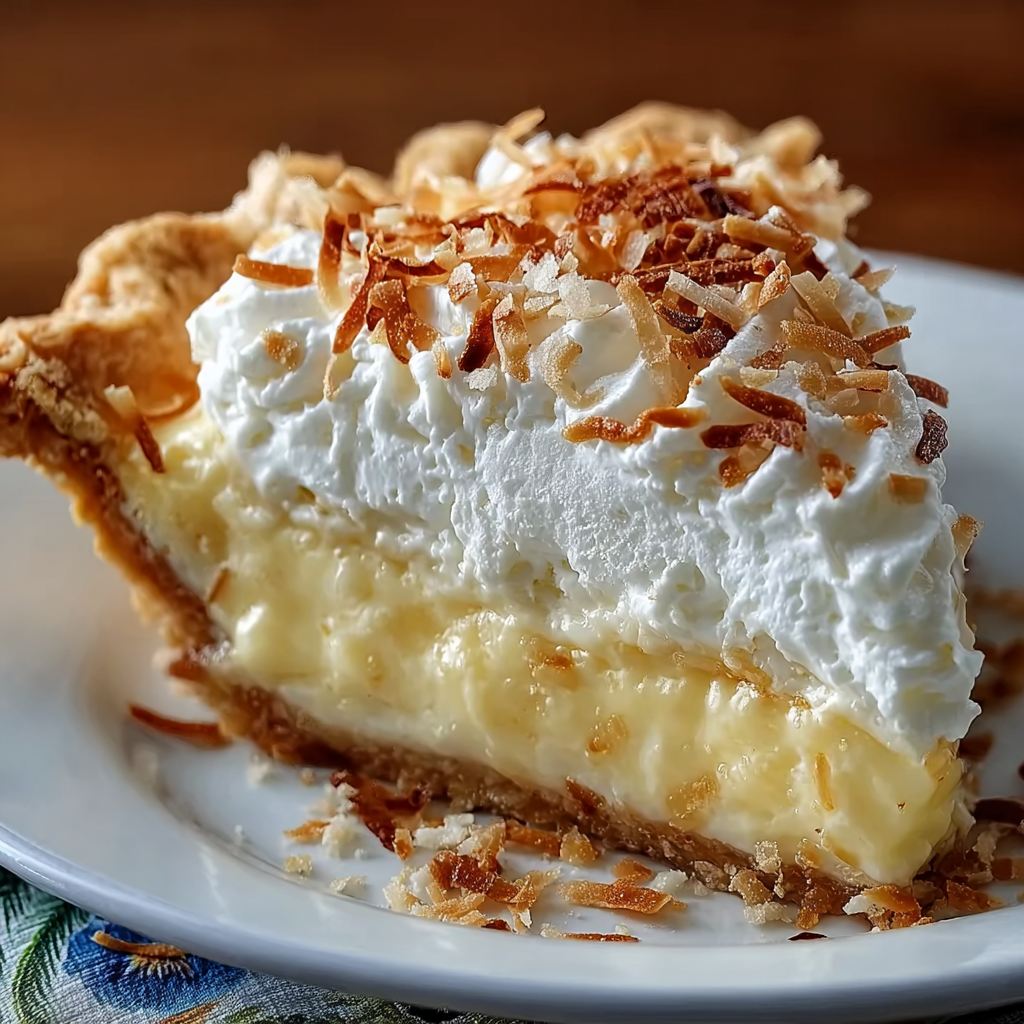
FAQs
How can I keep my coconut pie crust from turning soggy?
Always prebake (blind-bake) the crust until it’s golden, then let it cool fully before adding the filling—this seals the pastry and prevents steam from making it soggy.
Is it possible to swap coconut milk for coconut cream in the filling?
Absolutely—halve the recipe’s whole milk, then whisk in coconut cream thoroughly to maintain a creamy texture and prevent separation.
What’s the most effective method for evenly toasting shredded coconut?
Arrange coconut in a single layer in a dry skillet over medium heat, stirring every 1–2 minutes. This ensures uniform browning without burning.
How long can I store leftover coconut cream pie?
When covered tightly in the fridge, leftovers stay fresh for up to 4 days. For longer storage, wrap the pie well and freeze.
Can I make this coconut pie completely dairy-free?
Yes—replace whole milk with full-fat coconut milk, swap in vegan butter for dairy butter, and finish with a coconut-based whipped topping.
The Complete Guide to Perfect Coconut Cream Pie: Filling, Crust & Toppings
Experience a slice of tropical bliss with this Toasted Coconut Cream Pie. A crisp, graham cracker crust cradles a luscious coconut-infused custard, brightened with a hint of vanilla. Topped with billowy whipped cream and crowned by shards of golden toasted coconut, each mouthful offers a delightful interplay of textures—from crunchy to silky to airy. Ideal for summer gatherings or as a stunning finale to any meal, this pie elevates classic flavors with a sophisticated, homemade touch.
- Author: Clara
Ingredients
For the crust:
- 1 ½ cups graham cracker crumbs
- ⅓ cup melted butter
- ¼ cup granulated sugar
For the filling:
- 1 cup whole milk
- 1 cup coconut milk
- ⅔ cup granulated sugar
- ¼ cup cornstarch
- ¼ tsp salt
- 4 large egg yolks
- 1 tbsp butter
- 1 tsp vanilla extract
- 1 ½ cups sweetened shredded coconut
For the topping:
- 1 cup heavy whipping cream
- 2 tbsp powdered sugar
- ½ tsp vanilla extract
- ¼ cup toasted coconut
Instructions
Preheat the oven to 350°F (175°C).
Combine graham cracker crumbs, melted butter, and sugar in a bowl. Press into the bottom and up the sides of a 9-inch pie plate. Bake for 10 minutes, then let cool completely.
In a medium saucepan, whisk together the milk, coconut milk, sugar, cornstarch, and salt over medium heat.
In a separate bowl, lightly beat the egg yolks.
Slowly pour about ½ cup of the hot milk mixture into the yolks while whisking constantly to temper them, then pour the yolk mixture back into the saucepan.
Continue cooking over medium heat, whisking constantly, until the mixture thickens and starts to bubble.
Remove from heat and stir in butter, vanilla, and shredded coconut.
Pour the filling into the cooled crust and smooth the top.
Cover with plastic wrap (pressing it gently onto the surface) and refrigerate for at least 4 hours or until set.
In a mixing bowl, beat the whipping cream, powdered sugar, and vanilla extract until stiff peaks form.
Spread the whipped cream over the chilled pie and top with toasted coconut before serving.
Notes
-
For a deeper coconut profile, swap half the whole milk for extra coconut milk or cream.
-
Press crumbs firmly but evenly to avoid thin spots in the crust.
-
When tempering yolks, add hot mixture slowly—this prevents curdling.
-
Chill the pie overnight for best slicing and flavor melding.
-
Store leftovers sealed in the fridge; return slices to a warm oven (300°F/150°C) for 3 minutes to restore crust crispness.
